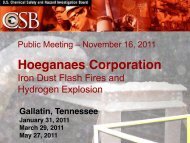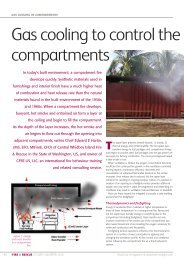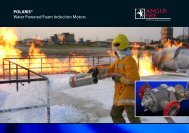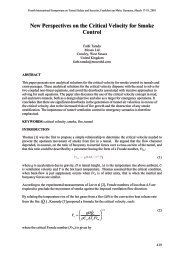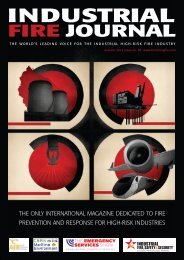Evacuation in Complex Environments - Industrial Fire Journal
Evacuation in Complex Environments - Industrial Fire Journal
Evacuation in Complex Environments - Industrial Fire Journal
Create successful ePaper yourself
Turn your PDF publications into a flip-book with our unique Google optimized e-Paper software.
Fourth International Symposium on Tunnel Safety and Security, Frankfurt am Ma<strong>in</strong>, Germany, March 17-19, 2010<br />
CONCLUSIONS<br />
The ma<strong>in</strong> conclusions of the present study are:<br />
- In complex environments it is necessary to use well designed fire alarms <strong>in</strong> order to reach all<br />
persons with proper <strong>in</strong>formation. If possible the fire alarm should be a spoken message.<br />
- Signage <strong>in</strong>dicat<strong>in</strong>g escape routes must be clearly visible even if the light <strong>in</strong> the environment is<br />
poor or uses a special colour.<br />
- Persons work<strong>in</strong>g <strong>in</strong> complex environments must be subjected to repeatedly evacuation<br />
exercises so they become with the familiarity with the situation. A fire <strong>in</strong> a complex<br />
environment is usually regarded more hazardous than others due to the complexity.<br />
- The comb<strong>in</strong>ation of exercises (experiments) and modell<strong>in</strong>g is necessary for hav<strong>in</strong>g a full<br />
understand<strong>in</strong>g of the difficulties dur<strong>in</strong>g a fire <strong>in</strong> a tunnel dur<strong>in</strong>g construction.<br />
REFERENCES<br />
1. Moss Haber, G. “Human behaviour <strong>in</strong> fire <strong>in</strong> total <strong>in</strong>stitutions; A case study”. In D. Canter<br />
(Ed.), <strong>Fire</strong>s and Human Behaviour (pp. 137-154). John Wiley & Sons Ltd, Chichester, 1980.<br />
2. Shields, T. J., & Boyce, K. E. “A study of evacuation from large retail stores”. <strong>Fire</strong> Safety<br />
<strong>Journal</strong>, 35(1), 25-49, 2000.<br />
3. Frantzich, H. “Occupant Behaviour and Response Time – Results from <strong>Evacuation</strong><br />
Experiments”. Proceed<strong>in</strong>gs of the 2nd International Symposium on Human Behaviour <strong>in</strong> <strong>Fire</strong>,<br />
pp 159-165, 2001.<br />
4. Tait, J., C., Høj N., P. “Storebælt eastern railway tunnel: Dania tunnel bor<strong>in</strong>g mach<strong>in</strong>e fire -<br />
analysis and recovery”. Supplement to Civil Eng<strong>in</strong>eer<strong>in</strong>g 114, special issue 1, Storebælt<br />
Eastern Railway Tunnel, 1996.<br />
5. Frantzich, H. & Nilsson, D. “<strong>Evacuation</strong> In <strong>Complex</strong> <strong>Environments</strong> - An Analysis Of<br />
<strong>Evacuation</strong> Conditions In a Nuclear Power Plant and A Tunnel Construction Site”.<br />
Proceed<strong>in</strong>gs of the 4th Int. Symp. on Human Behaviour <strong>in</strong> <strong>Fire</strong>, Rob<strong>in</strong>son College,<br />
Cambridge, UK, pp 207-218, 13-15 July 2009.<br />
6. Ingason, H. “<strong>Fire</strong> dynamics <strong>in</strong> tunnels”. In A. Beard and R. Carvel (Eds.) The handbook of<br />
tunnel fire safety (pp. 231-266). Thomas Telford Publ., London, 2005.<br />
7. Purser, D. “Assessment of Hazards to Occupants from Smoke, Toxic Gases and Heat”. In P.J.<br />
DiNenno et al. (Eds.) The SFPE Handbook of <strong>Fire</strong> Protection Eng<strong>in</strong>eer<strong>in</strong>g, 4th ed. National<br />
<strong>Fire</strong> Protection Association, Qu<strong>in</strong>cy, 2008.<br />
190



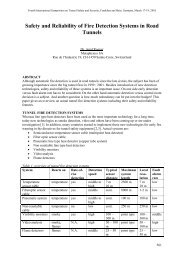

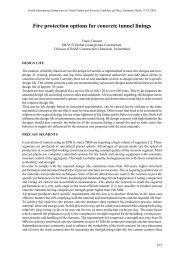
![30-37 TunnelsREV[1]rev.qxd - Industrial Fire Journal](https://img.yumpu.com/22237435/1/184x260/30-37-tunnelsrev1revqxd-industrial-fire-journal.jpg?quality=85)
